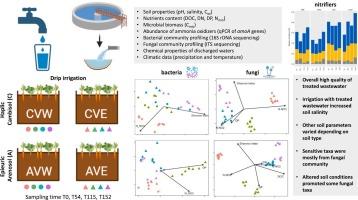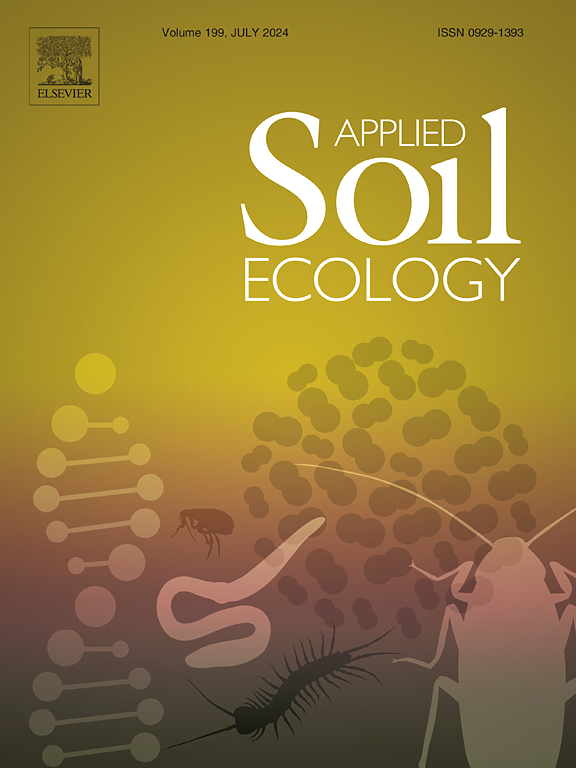Arenosol Epieuric and Haplic Cambisol show a similar level of resilience of microbial communities when irrigated with treated wastewater in a temperate climate
IF 4.8
2区 农林科学
Q1 SOIL SCIENCE
引用次数: 0
Abstract
The reuse of treated wastewater for irrigation purposes in agriculture is a common but controversial means of saving freshwater and providing plants with nutrients. It often leads to a change in physico-chemical properties and the introduction of uncontrolled amounts of pollutants into the soil. As a result, the structures and functions of soil microbial communities can change to an unknown extent. The aim of this study was to investigate the effect of treated wastewater on the abundance, diversity, and composition of bacteria, fungi, and ammonia oxidizers in two arable soils, the Arenosol and Cambisol. The raised soil beds were regularly irrigated with tap water (W) or effluent (E) and used for a vegetable crop rotation. Changes in soil chemical properties, nutrient content, abundance and composition of ammonia oxidizers, bacteria, and fungi were evaluated after 0, 54, 115, and 152 days. Irrigation with effluent led to an increase in salinity in both soils, while dissolved organic carbon (C) content, nitrate concentration and oxidizable C content showed soil-dependent response. Neither soil bacteria nor ammonia oxidizers were affected by the effluent in any soil, but time-dependent differences between fungal communities between W- and E-irrigated soils were observed. Our results indicate microbial taxa or guilds that were more sensitive to wastewater irrigation (Apiotrichum) and those that can thrive in altered soil conditions (Plectosphaera and Pseudopithomyces). However, this effect was overshadowed by changes caused by the crop rotation, indicating high quality of treated wastewater used for irrigation.

在温带气候条件下,用经处理的废水灌溉 Arenosol Epieuric 和 Haplic Cambisol 时,微生物群落表现出相似的恢复能力
将处理过的废水回用于农业灌溉是节约淡水和为植物提供养分的一种常见手段,但却备受争议。它通常会导致物理化学性质的改变,并将不受控制的污染物引入土壤。因此,土壤微生物群落的结构和功能会发生未知程度的变化。本研究的目的是调查经过处理的废水对两种可耕地土壤(阿伦诺溶胶和寒武溶胶)中细菌、真菌和氨氧化剂的数量、多样性和组成的影响。高架土床定期用自来水(W)或污水(E)灌溉,并用于蔬菜轮作。经过 0 天、54 天、115 天和 152 天后,对土壤化学性质、养分含量、氨氧化剂、细菌和真菌的丰度和组成的变化进行了评估。污水灌溉导致两种土壤的盐度增加,而溶解有机碳(C)含量、硝酸盐浓度和可氧化C含量则表现出土壤依赖性反应。任何土壤中的土壤细菌和氨氧化剂都没有受到污水的影响,但观察到 W- 和 E- 灌溉土壤中真菌群落的差异与时间有关。我们的研究结果表明,微生物类群或类群对废水灌溉更为敏感(Apiotrichum),而那些能在改变的土壤条件下茁壮成长的微生物类群或类群(Plectosphaera 和 Pseudopithomyces)则对废水灌溉更为敏感。然而,轮作引起的变化掩盖了这种影响,这表明用于灌溉的经过处理的废水质量很高。
本文章由计算机程序翻译,如有差异,请以英文原文为准。
求助全文
约1分钟内获得全文
求助全文
来源期刊

Applied Soil Ecology
农林科学-土壤科学
CiteScore
9.70
自引率
4.20%
发文量
363
审稿时长
5.3 months
期刊介绍:
Applied Soil Ecology addresses the role of soil organisms and their interactions in relation to: sustainability and productivity, nutrient cycling and other soil processes, the maintenance of soil functions, the impact of human activities on soil ecosystems and bio(techno)logical control of soil-inhabiting pests, diseases and weeds.
 求助内容:
求助内容: 应助结果提醒方式:
应助结果提醒方式:


